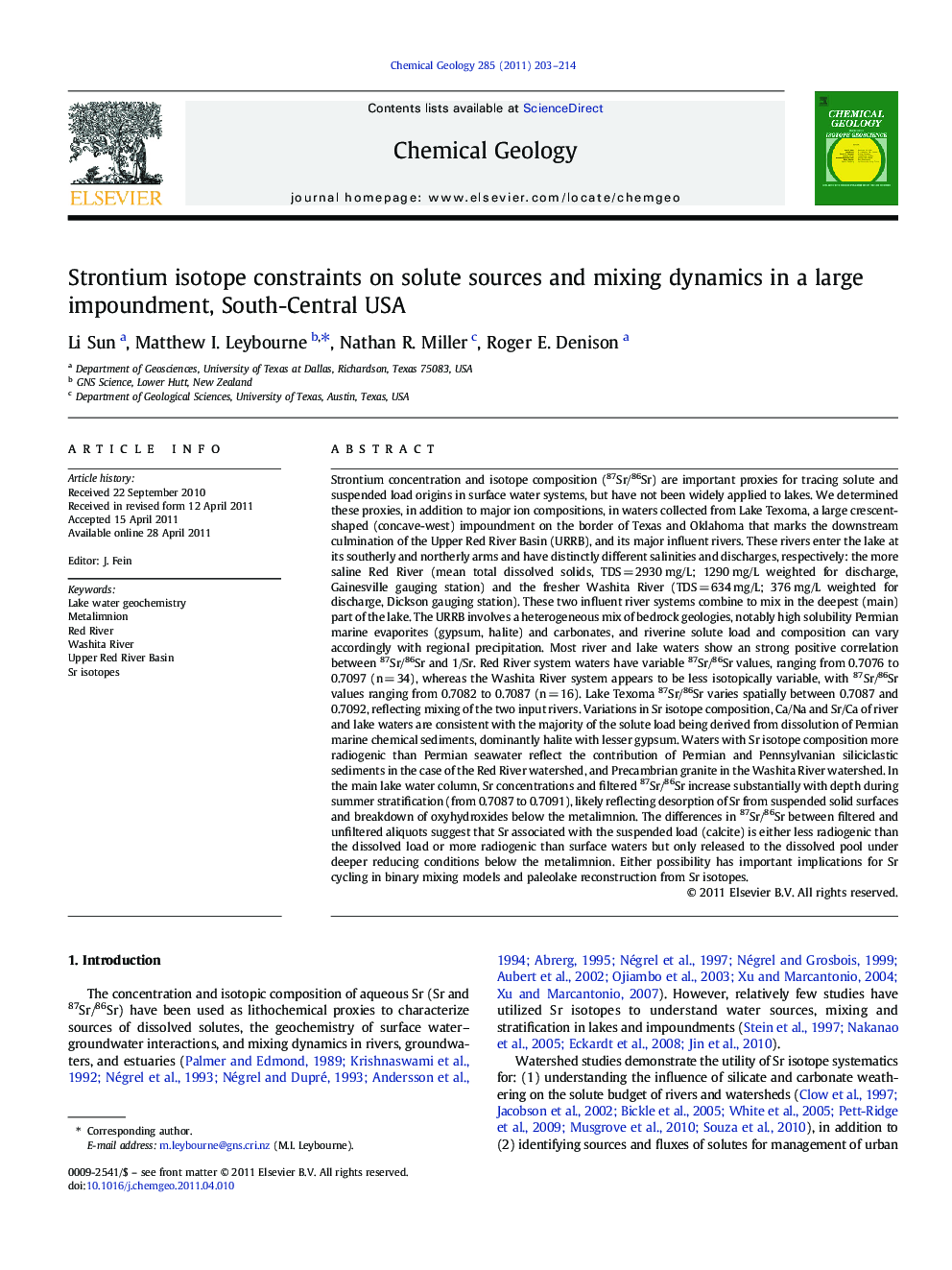| کد مقاله | کد نشریه | سال انتشار | مقاله انگلیسی | نسخه تمام متن |
|---|---|---|---|---|
| 4699683 | 1637666 | 2011 | 12 صفحه PDF | دانلود رایگان |

Strontium concentration and isotope composition (87Sr/86Sr) are important proxies for tracing solute and suspended load origins in surface water systems, but have not been widely applied to lakes. We determined these proxies, in addition to major ion compositions, in waters collected from Lake Texoma, a large crescent-shaped (concave-west) impoundment on the border of Texas and Oklahoma that marks the downstream culmination of the Upper Red River Basin (URRB), and its major influent rivers. These rivers enter the lake at its southerly and northerly arms and have distinctly different salinities and discharges, respectively: the more saline Red River (mean total dissolved solids, TDS = 2930 mg/L; 1290 mg/L weighted for discharge, Gainesville gauging station) and the fresher Washita River (TDS = 634 mg/L; 376 mg/L weighted for discharge, Dickson gauging station). These two influent river systems combine to mix in the deepest (main) part of the lake. The URRB involves a heterogeneous mix of bedrock geologies, notably high solubility Permian marine evaporites (gypsum, halite) and carbonates, and riverine solute load and composition can vary accordingly with regional precipitation. Most river and lake waters show an strong positive correlation between 87Sr/86Sr and 1/Sr. Red River system waters have variable 87Sr/86Sr values, ranging from 0.7076 to 0.7097 (n = 34), whereas the Washita River system appears to be less isotopically variable, with 87Sr/86Sr values ranging from 0.7082 to 0.7087 (n = 16). Lake Texoma 87Sr/86Sr varies spatially between 0.7087 and 0.7092, reflecting mixing of the two input rivers. Variations in Sr isotope composition, Ca/Na and Sr/Ca of river and lake waters are consistent with the majority of the solute load being derived from dissolution of Permian marine chemical sediments, dominantly halite with lesser gypsum. Waters with Sr isotope composition more radiogenic than Permian seawater reflect the contribution of Permian and Pennsylvanian siliciclastic sediments in the case of the Red River watershed, and Precambrian granite in the Washita River watershed. In the main lake water column, Sr concentrations and filtered 87Sr/86Sr increase substantially with depth during summer stratification (from 0.7087 to 0.7091), likely reflecting desorption of Sr from suspended solid surfaces and breakdown of oxyhydroxides below the metalimnion. The differences in 87Sr/86Sr between filtered and unfiltered aliquots suggest that Sr associated with the suspended load (calcite) is either less radiogenic than the dissolved load or more radiogenic than surface waters but only released to the dissolved pool under deeper reducing conditions below the metalimnion. Either possibility has important implications for Sr cycling in binary mixing models and paleolake reconstruction from Sr isotopes.
Research highlights
► 87Sr/86Sr & major ion ratios indicate halite and gypsum dissolution in the watershed.
► Sr (mg/L) and filtered 87Sr/86Sr increase with depth during summer stratification.
► Increase reflects desorption of Sr & breakdown of oxyhydroxides below the metalimnion.
► 87Sr/86Sr more radiogenic in filtered than unfiltered aliquots below the metalimnion.
► Suspended load (calcite) is therefore less radiogenic than the dissolved load.
Journal: Chemical Geology - Volume 285, Issues 1–4, 22 June 2011, Pages 203–214